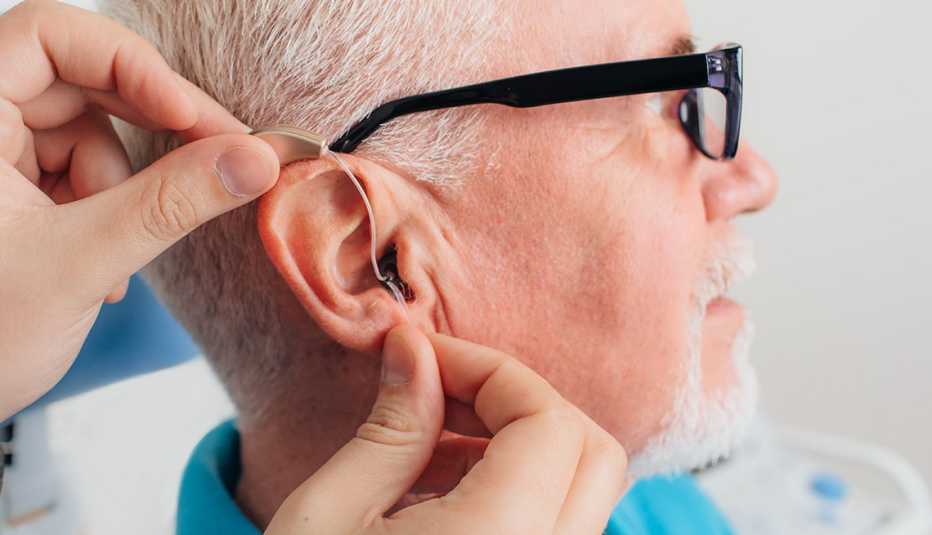AARP Hearing Center


If you haven't upgraded your hearing aids in three to five years, or have been putting off hearing tests because of the stigma of wearing the devices, it may be time to discover what's new.
The technology is more advanced than ever. But even less expensive hearing aids offer sound and speech processing, digital noise and wind noise reduction, plus improved management of feedback — those annoying high-pitched screeches, squeals and whistles. These features work together to ensure that the sound going into your ears is clearer, not just louder.
"I have participated in studies showing that with all of the latest technologies being incorporated into hearing aids, the less expensive models often work just as well as the most expensive models. But they have fewer bells and whistles,” says Nicholas S. Reed, an audiologist and assistant professor at Johns Hopkins University Bloomberg School of Public Health in Baltimore.
ENT, audiologist or
hearing aid dispenser?
All hearing specialists have to pass state licensing exams to serve patients. The amount of education is generally the difference among these professionals:
• Otolaryngologist. This medical doctor — also known as an ear, nose and throat (ENT) specialist — diagnoses the causes of hearing loss and determines whether hearing aids are needed.
• Audiologist. This clinical practitioner assesses and treats hearing and balance disorders, can determine the need for hearing aids and the type best-suited for a patient. Most have doctorates in audiology (Au.D, although others have a Ph.D., doctor of science (Sc.D.) or master's degree.
• Hearing aid dispenser/hearing instrument specialist. Each state regulates the training needed to become a licensed professional who fits and dispenses hearing aids. Many require an apprenticeship program with an experienced audiologist or hearing aid dispenser; others may require a two-year degree from an accredited program or even a master's degree in audiology.
Most people who have bought the most expensive and cutting-edge hearing aids never wind up using the extra features and functionality, research shows.
"The benefits someone receives from wearing hearing aids is often more of a function of how well they're fitted to them,” says Abram Bailey, an audiologist and president of Austin, Texas-based HearingTracker.com, a shopping resource for hearing aid consumers.
So you don't necessarily need to purchase the most expensive and technologically advanced equipment. But you do need to work with a skilled audiologist, hearing instrument specialist or hearing aid dispenser to match the devices to your needs and ears.
"The one critical thing I recommend a patient look for is an audiologist who runs real ear verification tests on everyone when fitting and customizing hearing aids,” Bailey says. “This is a test where a tiny microphone is placed within the ear along with the hearing aid to measure the hearing aid's output” and what the patient actually hears.
Though the insides of people's ears have the same basic shape, little differences can change how sound bounces around before it hits the eardrum. The size of the ear canal, where the hearing aid's speaker is placed within it and personal preference for louder or softer sounds from the device are among the variations that play a part.
Hearing aids generally last four to seven years, according to manufacturers. Ones that sit within the ear tend to have a lifespan on the shorter end of the scale because they're exposed to more earwax and even sweat inside the ear canal.
But like smartphones and smart TVs, some of the newest hearing aids have features not available even a few years ago. That doesn't always mean higher prices because the devices take advantage of advances in chips developed for Bluetooth headsets, computers and smartphones. Competition from less expensive personal sound amplification products (or PSAPs, pronounced PEE-saps), devices that aren't regulated by the FDA like hearing aids, also plays a part.
"Whether or not you should pay extra for a hearing aid with certain functionality should depend on if you plan to use those functions or not,” Reed says. “If a feature is not something you need, you already have on another device or it's something you know you won't use, look for hearing aids that don't require you to pay extra for those functions."

































































More on health
The Ins and Outs of Safe Earwax Removal
Safely removing the gunk will help you feel and hear betterArtificial Intelligence Can Help Pick Voices Out of a Crowd
A Google breakthrough could lead to more effective hearing aidsSmartwatches Are Turning Into Emergency Alert and Tracking Devices
Caregivers, their loved ones can use new features to their advantage